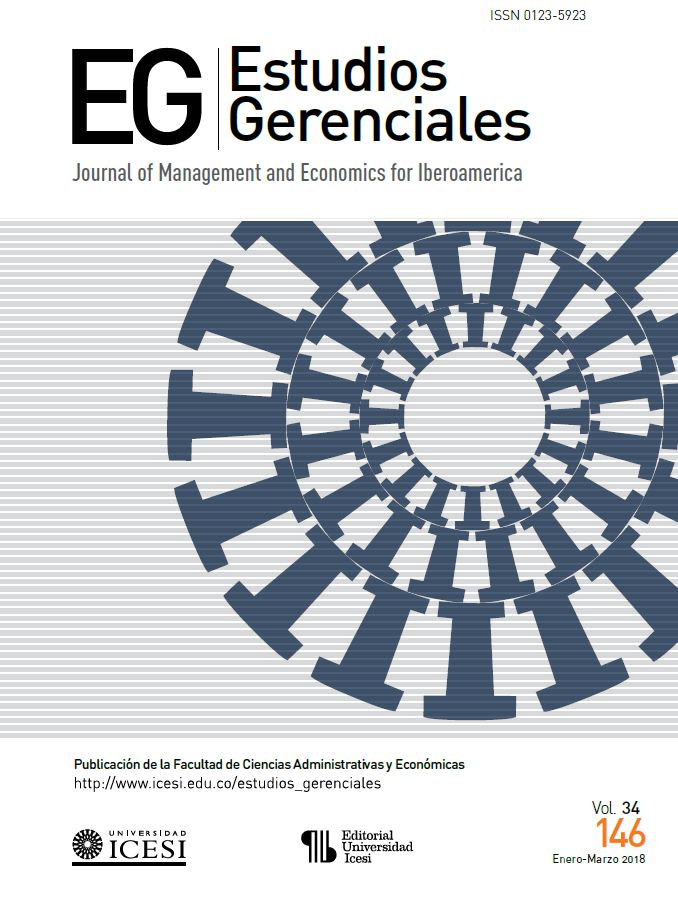Distrinox, how to grow profitably?
DOI:
https://doi.org/10.18046/j.estger.2018.146.2805Keywords:
Market orientation, Customer management, Growth, ProfitabilityAbstract
This case study aims to put into practice the customer management concept in a Colombian firm that imports and sells stainless steel to ensure its profitable growth. In order to achieve this goal, information about the market, the competitors, the company as well as its products and customers is provided for the reader to define actions regarding the products and services portfolio to grow profitably.
Downloads
References
Anderson, J. C., Narus, J. A. y Narayandas, D. (2009). Business Market Management: Understanding, Creating, and Delivering Value (3ra ed.). Upper Saddle River: Pearson Prentice Hall.
Barney, J. B. (2001). Resource-based theories of competitive advantage: A ten-year retrospective on the resource-based view. Journal of Management, 27(6), 643-650.
Barney, J. B. (2014). How marketing scholars might help address issues in resource-based theory. Journal of the Academy of Marketing Science, 42(1), 24-26.
Blattberg, R. C. y Deighton, J. (1996). Manage marketing by the customer equity test. Harvard Business Review, 74(4), 136-144.
Castellanos Ordoñez, G. y Solano Arboleda, D. (2017). Metaanálisis de la relación entre la orientación al mercado y los resultados de la empresa. Estudios Gerenciales, 33(142), 87-94. http://doi.org/10.1016/j.estger.2016.10.006
Day, G. S. (2003). Creating a superior customer-relating capability. MIT Sloan Management Review, 44(3), 77-82.
Deshpande, R., Farley, J. y Webster, F. (1993). Corporate culture, customer orientation, and innovativeness. Journal of Marketing, 57(1), 23-27. http://doi.org/10.2307/1252055
El Tiempo. (2016). Panorama económico de Colombia en 2017. Recuperado el 24 de octubre de 2017 de: http://www.eltiempo.com/economia/sectores/panorama-economico-de-colombia-en-2017-38145
Heskett, J. L. y Schlesinger, L. A. (1994). Putting the service-profit chain to work. Harvard Business Review, 72(2), 164-174.
Hunt, S. D. y Lambe, C. J. (2000). Marketing’s contribution to business strategy: market orientation, relationship marketing and resource‐advantage theory. International Journal of Management Reviews, 2(1), 17-43.
Kohli, A. K. y Jaworski, B. J. (1990). Market orientation: the construct, research propositions, and managerial implications. The Journal of Marketing, 54(2), 1-18.
Kotler, P. y Amstrong, G. (2013). Fundamentos de Marketing (11 ed.). Naucalpan de Juárez: México: Pearson Educacion.
Legiscomex. (2017). Base de datos. Recuperado el 24 de octubre de 2017 de: https://www.legiscomex.com
Narayandas, D. (2002). Note on Customer Management. Harvard Business School Publishing, N° 502073.
Narver, J. C. y Slater, S. F. (1990). The effect of a market orientation on business profitability. The Journal of Marketing, 54(4), 20-35.
Peppers, D., Rogers, M. y Dorf, B. (1999). Is your company ready for one-to-one marketing. Harvard Business Review, 77(1), 151-160.
Porter, M. E. (1998). The Competitive Advantage: Creating and sustaining superior performance. New York: Free Press.
Rodriguez-Cano, C., Carrillat, F. A. y Jaramillo, F. (2004). A meta-analysis of the relationship between market orientation and business performance: evidence from five continents. International Journal of Research in Marketing, 21(2), 179-200.
Downloads
Published
Issue
Section
License
Articles are the sole responsibility of their authors, and will not compromise Icesi’s University principles or policies nor those of the Editorial Board of the journal Estudios Gerenciales. Authors authorize and accept the transfer of all rights to the journal, both for its print and electronic publication. After an article is published, it may be reproduced without previous permission of the author or the journal but the author(s), year, title, volume, number and range of pages of the publication must be mentioned. In addition, Estudios Gerenciales must be mentioned as the source (please, refrain from using Revista Estudios Gerenciales).








